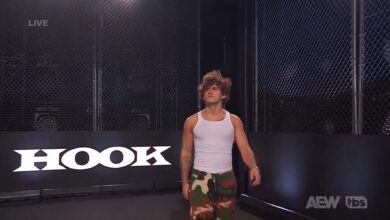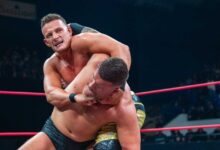A Look Back: Ten Years After the Deaths of Nancy, Daniel and Chris Benoit

A little over ten years ago the name “Chris Benoit” denoted much of what was excellent about pro wrestling. Benoit was respected for two decades, by fans and peers alike, as one of the best in-ring performers in the world. His fundamentals were as near to perfect as anyone who had ever stepped foot in a ring, rivaled perhaps only by his hero, “The Dynamite Kid” Tom Billington.
Today Benoit reminds us of something so horrifying WWE has virtually redacted him from their account of history. His name is avoided in blurb descriptions for past events on the WWE Network in which he was prominently featured. His name has probably never been uttered on WWE programming again since the days allowing the death of his wife, son and himself.
It’s hard to explain to those weren’t fans at the time just how shocking the incident was. Before his demise, Benoit was not just a bit player in wrestling but someone who was idolized.
When my friends and I were training to be wrestlers in the early 2000s, there were three wrestlers they looked up to and studied more than any others: Kurt Angle, Eddy Guerrero and Chris Benoit.
By 2007, two of them were dead and another was released from WWE for fear he might die from a substance abuse problem.
It was all-too eerie that the Benoit killings happened in the midst of a tasteless angle in which the Vince McMahon character purportedly died when his limousine exploded into flames, all the while the real death of former WWE manager Sherri Martel went ignored on WWE programming.
Since news of the family’s deaths emerged to the public on Monday, June 25, 2007, there have been many grasps at explanations: Was it due to the numerous head injuries Benoit sustained throughout his career and the chronic traumatic encephalopathy (CTE) the autopsy showed he was suffering from? Was it mental illness? An escalation of previous episodes of domestic violence? ‘Roid rage? Some combination of all of the above?
In 2017 I don’t think we have any clearer answers than we did in 2007. We may never understand what went through Chris’ mind that weekend as he strangled his wife Nancy on Friday night, June 22, 2007; then smothered their seven-year-old son Daniel some time later in the weekend before hanging himself from a weight-lifting pulley.
Chris was deeply consumed by pro wrestling, and that culture was surrounded again and again by the untimely deaths of his peers and friends.
Speaking about his career in the “Hard Knocks” documentary WWE put out on DVD shortly after his 2004 WWE World Heavyweight Title win, Benoit said of himself:
“When I say, ‘Chris Benoit, the wrestler’– wrestling has consumed my life. Wrestling is my mistress. It’s my passion. So it defines a lot about who I am as a person.”
In the same documentary, Chris’s father, Michael Benoit explains Chris knew immediately after seeing a Stampede Wrestling show in Edmonton, Alberta, Canada, as a child that he wanted to be a pro wrestler.
“His love, really from the age of twelve or thirteen, was wrestling. He got to see the Dynamite Kid and that was it. That’s all he wanted to do.”
While his early desire to become a pro wrestler isn’t all that different from many others who realized their dream, his passion to be the best went deep. Chris Jericho tells a story in a 2016 episode of Talk is Jericho about Benoit punishing himself for a single bad spot in an otherwise good match they had together in Japan in the 1990s.
“He was so angry with that that after the match I couldn’t find him anywhere. I went looking everywhere and he’s standing in the corner of a boiler room area… [We] had a great match but that one moment he couldn’t let go of. He said, ‘I have to do squats.’ He had to purge himself. I felt like, okay, I had to do them with him. Five hundred hack squats.”
Some of Benoit’s greatest matches spring to mind the deaths of other wrestlers who were his friends.
Bret Hart specifically asked Benoit to be his opponent to pay tribute to Bret’s brother Owen Hart, following Owen’s death in 1999.
With Jericho and Steven (William) Regal in 1998 and 2000, respectively, he had memorable matches at tribute shows held for the late Brian Pillman.
By many accounts, Benoit was a private, reserved person with only a few close friends. Most of all Benoit was crushed by the sudden passing on November 13, 2005, of his best friend, Eddy Guerrero.
“[Eddy] was the one friend that I had that I could go to and pour my heart out to if I was going through something,” Benoit confessed into the camera on the episode of RAW that followed Eddy’s death. “If I had a personal issue or personal problem he was the one guy that I could call and I could talk to and know that he would understand and he would talk me out of it because of all the experiences that he’d been through.”
According to Nancy Benoit’s sister, Sandra Toffoloni (who spoke with Jericho on the same episode of his podcast), after Eddy died Chris was in “a state of perpetual bereavement”.
Nancy bought a journal for Chris to use to write letters to Eddy. Chris wrote fondly to Eddy about Nancy and Daniel.
“I’ll be with you soon,” Chris wrote, according to Cary Ichter, Michael Benoit’s lawyer.
“[The journal] showed that he was very depressed,” Ichter told the Associated Press in 2007.
“The medical examiner told us after the autopsy that Chris was on his way to death within ten months,” Toffoloni said in a 2013 interview. “His heart was huge, about three times normal size, and it was ready to blow up at any moment.”
Just a few months after Eddy died, Chris lost more friends. Mike Durham (Johnny Grunge) died in January 2006 at age 39. The next month his former mentor Victor Manuel (Black Cat) died of heart attack.
Toward the end of his life, it sounds as if Chris was trying to move away from being a full-time wrestler. According to Toffoloni, Chris was considering getting out of WWE and starting his own wrestling school.
Rob Van Dam told Maxim in 2007 of a conversation he’d had with Chris shortly before his death.
“I have so much respect for you leaving [WWE],” Van Dam says Chris told him. “A lot of us don’t know when to walk away from this business.”
Van Dam, whose WWE contract had just expired, went on: “It seemed like he was saying, ‘Damn, I wish I could walk away right now.’”
While nothing can justify Chris’s final acts, in hindsight his life seems to have been affected by some of the worst parts of the wrestling industry’s culture.
At roughly 5’8”, Chris felt pressured to make his body as big as possible so he could compete for opportunities in an industry that valued size and muscular physiques. Maybe “roid rage” played a role, maybe it didn’t; it almost certainly didn’t in the clearly premeditated killing of Daniel, which happened some hours after the killing of Nancy.
The deaths of Chris’s wrestler-peers probably devastated the emotional support he could formerly rely on from friends. His determination to overachieve in the ring and produce outstanding, physical matches injured his brain to the point he was increasingly paranoid toward the end of his life. Perhaps his guarded personality and a stigma from society in general about mental illness discouraged him from seeking whatever help he needed.
Following the death of Eddy Guerrero, WWE instituted its Wellness Policy that included stricter drug testing. After the deaths of the Benoit family, Vince McMahon was called before a congressional subcommittee in 2009 to defend that policy. Related or not, wrestlers don’t die these days at the rate they did in years past.
Still more can to be done to improve the cultures from which those terrible events descended: While there’s less of a premium on size and physiques than in the past, Jinder Mahal’s startling transformation probably contributed to the decision to make him WWE champion recently. Still too little is known about the effects of head injuries and even the subconcussive blows that wrestlers sustain perhaps in every match. Still too little is done about the dangers of domestic violence, by wrestling promoters and in society in general. And still there is an unjust stigma in wider culture about mental illness, as well as in the tough guy subculture of pro wrestling that may discourage us from reaching for help when we most need it.
The author’s proceeds from this article will be donated in equal parts to these three organizations: National Coalition Against Domestic Violence, Concussion Legacy Institute and National Alliance on Mental Illness.




